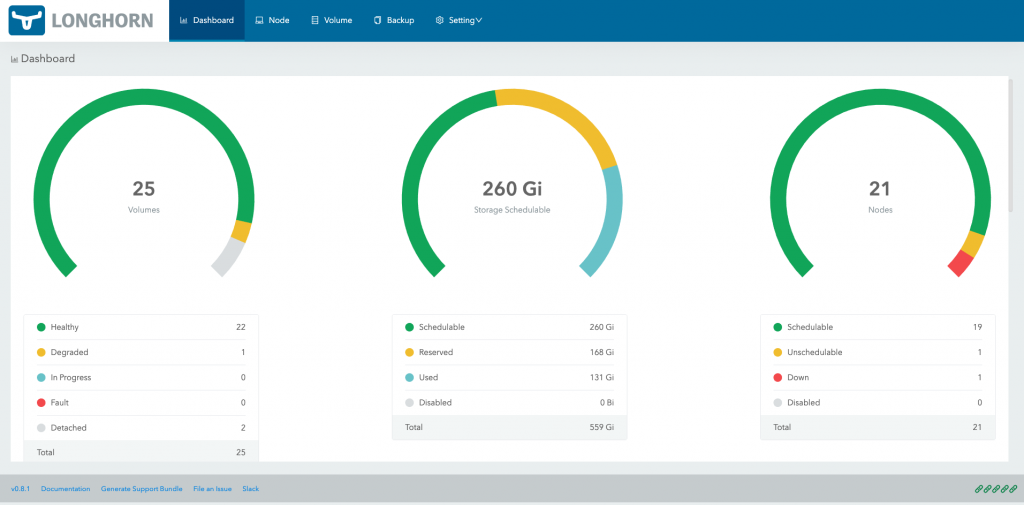Longhorn: The Case for Rancher’s Storage Offering
Will Longhorn storage adequately fill out Rancher’s Kubernetes management platform?
How to manage and store stateful data associated with container workloads represents yet another challenge for DevOps when making the shift to Kubernetes.
The main issue is how to integrate a storage platform and databases with a standalone Kubernetes management tool. In addition to selecting and installing a separate persistent storage solution, operations-related tasks include managing the integration and its functionality separately. While some vendors might seek to offer an entire A-to-Z solution from software development to deployment with storage capabilities built-in, Rancher has been among those providers offering a popular Kubernetes management platform devoid of storage capabilities.
Seeing the obvious gap in its offerings, Rancher introduced a beta version of Longhorn last year. Now Longhorn is generally available for persistent storage of data for stateful applications within Kubernetes that is integrated with Rancher’s Kubernetes management platform.
After becoming a CNCF Sandbox project last year, Rancher has seen strong demand for Longhorn “primarily driven by the increased need to run stateful workloads as Kubernetes becomes mainstream,” says Sheng Liang, co-founder and CEO of Rancher Labs. “Longhorn also further differentiates Rancher from other Kubernetes management platforms like OpenShift that does not include container-native storage functionalities.”
The Vendor Battle
The perceived necessity of including persistent storage capabilities with its Kubernetes offering from a strategic perspective reflects that “Rancher is doubling down on its anti-lock-in narrative,” Torsten Volk, an analyst for Enterprise Management Associates (EMA), says. “They are the only provider of managed but undiluted upstream Kubernetes.”
Rancher’s approach is thus different than that of Red Hat’s and VMware’s, for example, Volk says, noting these vendors seek to “push their entire stack on customers to cut out both traditional and cloud-native storage vendors.”
“You can almost compare this back to the old PC-versus-Mac debate, where as a Mac user, I’m sacrificing flexibility for simplicity. Which message will better resonate will depend on how much pain enterprise customers experience during the process of onboarding more of their traditional, mostly monolithic, apps to Kubernetes,” he continues. “Customers then need to decide if they are willing to run the Red Hat or VMware stack on AWS, Azure, GCP and friends in return for a unified operating model or if they want to try out Rancher to have more flexibility in terms of hybrid cloud cluster deployment.”
The Position of Toolsets
In many respects, adoption of Kubernetes is just continuing to come of age. While a recent survey conducted by Dimensional Insight for VMware indicated 59% of IT organizations surveyed had adopted Kubernetes, a non-negligible 41% still had yet to make the shift. Industrywide adoption of Kubernetes thus remains a work in progress in many respects, and as mentioned above, organizations continue to experiment with different approaches when managing stateful applications.
In this context, Rancher has become aware of the “importance of bread-and-butter enterprise computing requirements,” such as backup, snapshots and provisioning for the cloud-native universe, Volk says. “This is critical for their differentiation strategy against VMware and Red Hat on the one side and Google, Azure and Amazon on the other hand.”
The choice of platforms and tools continue to evolve as well, of course, as DevOps continues to mix and match different tools and platforms from different vendors.
“Rancher must show that it is not going to cost you your job when selecting their platform over VMware and Red Hat when re-platforming or modernizing enterprise applications. This is a big challenge that is similar in character to OpenStack trying to become everyone’s favorite open source cloud platform without being prescriptive regarding the underlying infrastructure,” Volk says. “On the plus side, Rancher controls its own fate while OpenStack has to deal with the conflicting interests of lots of individual vendors. This will be an interesting race to watch.”
 What’s On Offer
What’s On Offer
The range of functionality Longhorn offers, Rancher said, includes:
- Thin-provisioning, snapshots, backup and restore.
- Non-disruptive volume expansion.
- Cross-cluster disaster recovery volumes with defined recovery time objectives (RTOs) and recovery point objectives (RPOs).
- Live upgrades without impacting running volumes.
- Kubernetes CLI integration and standalone UI.
- The ability to allow organizations to deploy Longhorn on existing NFS iSCSI and Fibre Channel storage arrays and on cloud storage systems such as Amazon Elastic Block Store (EBS).
“By offering Longhorn as an integrated feature of Rancher, we simplify the steps users have to take to deploy stateful workload on Kubernetes clusters,” Liang says.





